Projectors offer an immersive viewing experience that rivals traditional TVs. But here’s the thing: even the best projectors can’t shine without the right canvas.
If you are in the market for a projector screen, or investigating your options for projectors and screens, I am here to add some perspective. I have bought cheap and expensive projector screens for indoor and outdoor use over the last three years.
If you are thinking about buying a portable projector, or an ultra short throw projector for a home theater setup, this guide can help you figure out what to buy.
I use a few different styles of projectors for both casual TV watching and weekly movie nights. And that means using different projector screens as well, depending on whether I am watching my projector indoors or in my backyard.
I use streaming services most of the time such as Amazon Prime Video, Disney+, Fubo and The Criterion Channel. But I dabble with my Plex home media server. And I watch OTA channels on my projectors as well.
Types of Projector Screens
Before we dive into my top picks, let’s cover the different types of projector screens available:
Fixed Frame Projector Screens
Fixed frame projector screens are ideal for dedicated home theaters. They provide a smooth, wrinkle-free surface that enhances image quality. These screens come in various sizes, generally starting at 100 inches and up.
Manual Projector Screens
If you’re on a budget, manual projector screens are a practical choice. They’re easy to set up and come in various widths, such as the popular 120-inch projection screen. However, manual screens may require more effort to assemble and store after use.
Portable Folding Projector Screens
Portable projector screens, often in the form of a tripod or retractable design, are perfect for backyard movie nights or impromptu media sessions. Look for options with a storage bag that makes the setup easy to carry and store.
Projector screens that I avoid
I have been asked about what I think of inflatable projector screens. So here’s my insights based on some hands-on testing that I have done with inflatable and non-inflatable screens.
While the setup for inflatable screens may be convenient for an outdoor movie night, they have one major drawback. Most inflatable screens are propped up by a small air compressor.
If the air compressor runs continuously, that means you will have a constant din competing with the projector’s speakers. The noise from the compressor can be distracting or downright unpleasant.
Manufacturers might claim it’s a quiet movie watching experience. But side by side testing with non-inflatable screens shows that inflatable screens can impact the audio coming from a projector, especially if you are using a portable projector with low-watt speakers.
Can there be exceptions to inflatable screens? Sure. But here is another thing to keep in mind.
When I am rating and reviewing projectors, I give low marks to any model that has noticeable fan noise. Having a projector screen that comes with added noise is worth avoiding when you have other screens that cost the same without the distraction.
Best Projector Screens for Everyday Use
Elite Screens Yard Master 2
I’ve been using the Yard Master 2 by a company called Elite Screens since July 2021. I bought this screen through Amazon after doing some research on screen materials, and different designs available in the consumer market.
I bought the 120 inch screen for $177 on Amazon. It currently retails for about $179.
The projection screen is made with material called CineWhite UHD-B; it’s a flexible PVC material that’s white on the front, and black on the back. It feels really thick in the hand and has equal brightness at an 180 degree angle.
The bag that the screen comes in is around the size of a golf bag and has all your parts. The screen itself is stored in a separate bag inside to protect it from dirt and debris.
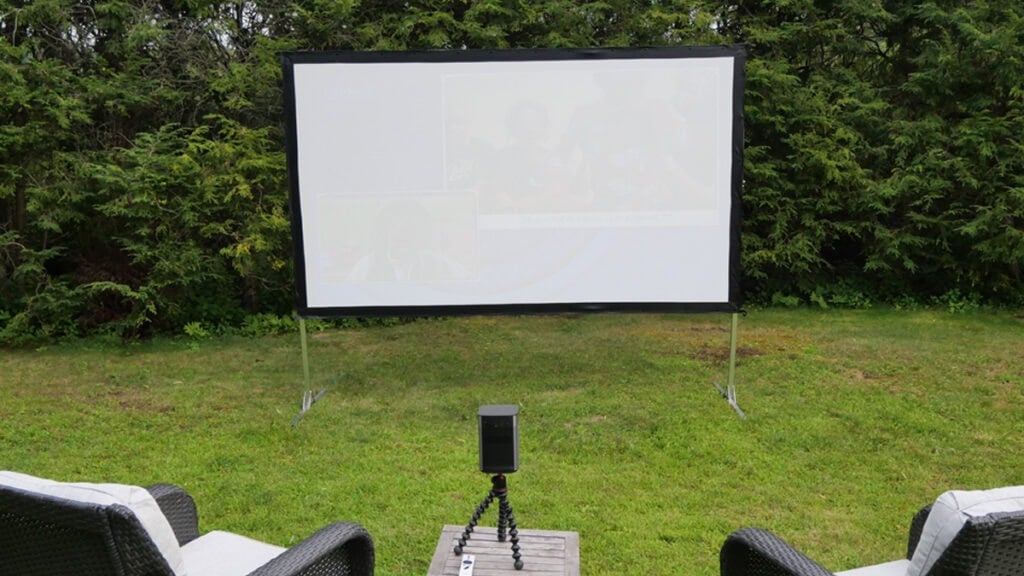
The first thing you do is unfold the frame of the screen; and then you screw it into the stand. Once that’s done you can lay the frame on its back and snap on the screen. Then you have four spikes and some rope that’s included to fully secure it into the ground.
I was surprised I was able to assemble the frame and attach the screen without any problems. But, if you have never assembled a screen like this before, there are a few tips you should know in advance.
Pro Tip: One challenging aspect of assembling the Yard Master screen is snapping the screen onto the frame. I have found that if I put the screen bag in the sun ahead of time, it slightly warms the material, making it easier to stretch as you snap it onto the frame.
When attaching the screen to the frame, make sure that you begin in one top corner and work your way around the screen. Do not snap in one corner and then another. Doing so will make attaching the screen more difficult.
After assembling the screen a few dozen times, I found that getting the screen more pliable with the sun, and working your way around the frame, makes a big difference.
The build quality of the frame is solid. It’s made of a lightweight aluminum. All the joints and fittings are well-cut and snap into place like they should.
I wanted something that I could quickly set up on my own. The Yard Master 2 delivers an impressive picture for watching a baseball game or a movie. It doesn’t take up much space in my garage.
According to Elite Screens, the CineWhite screen is also made for 4K projectors. So far, I have tested the Yard Master 2 with the XGIMI Halo Plus, the BenQ GS50 and the Nebula Capsule II. I’m really happy with my choice. The Yard Master 2 retails for about $179.
- See the latest price for the Yard Master 2 at Amazon.
OWLENZ 120” Projector Screen
If you are using a portable projector with low brightness, an inexpensive screen can give your image a boost. The OWLENZ 120” projector screen is a cloth screen that I bought in the spring of 2020.
I have used it for smaller projectors such as the Nebula Capsule II and Capsule Max, which emit a small amount of brightness. The Capsule Max has 200 ANSI lumens, meaning you can only use the projector at dusk or in a dark room.
The OWLENZ 120″ Projector Screen comes in a compact plastic package. For its price, the material is durable and well-made.
The OWLENZ has a sleek matte white screen surface bordered by a black frame. The screen material is thick and mostly stays wrinkle-free. I found that hanging it over time usually works out any wrinkles it might get when it’s stored away in a bag.
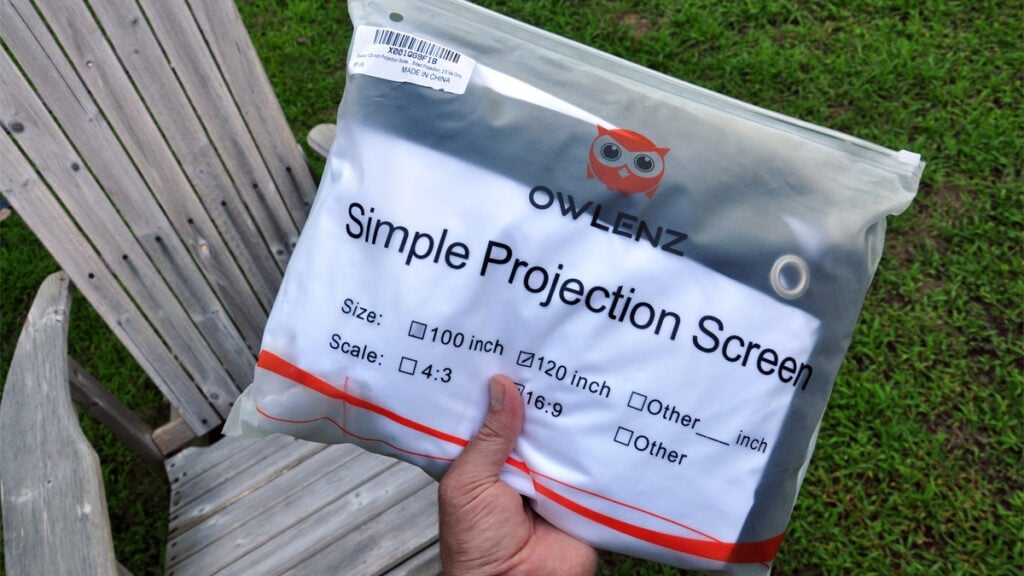
But, the trick is keeping it clean during assembly. A 120-inch screen measures about 10 feet diagonally. You want to keep the screen off the ground. Having a second person to help you unfold and hang the projector on the adhesive hooks helps you keep the screen in a good condition.
The OWLENZ screen includes 24 plastic adhesive hooks that you can connect to an indoor or outdoor wall. It also comes with two nylon ropes to help secure the screen.
I recommend finding a permanent home for the hooks because the adhesive tape isn’t strong enough for moving from location to location.
The screen does a great job of reflecting light evenly. Colors are vibrant, and the HD material does justice to an image with 720p or 1080p resolution. When compared to other screens I’ve used, the OWLENZ holds its own, especially at its price point. The OWLENZ projector screen retails for about $14.99.
- See the latest price for the OWLENZ projector screen at Amazon.
WEMAX ALR & CLR Ultra Short Throw Fixed Frame
If you have already bought a UST projector, or plan to, the difference between using a CLR/ALR screen vs a white wall is as different as night and day. But depending on the kind of projector you are using (and where you use it), you need to pay attention to screen material and gain when selecting a screen.
I spent about 8 weeks testing out WEMAX’s 120-inch ALR & CLR ultra short throw fixed-frame projector screen. I assembled the screen myself.
The CLR/ALR screen is designed for its ultra short throw projectors (UST projectors). I used the WEMAX Laser TV 4K Cinema for most of my testing.
The WEMAX ALR & CLR screen has an ambient light rejecting surface. An ALR screen helps to reduce glare and improve contrast, especially in well-lit rooms. The WEMAX screen also has a CLR surface, or a color light rejecting surface, that improves color accuracy.
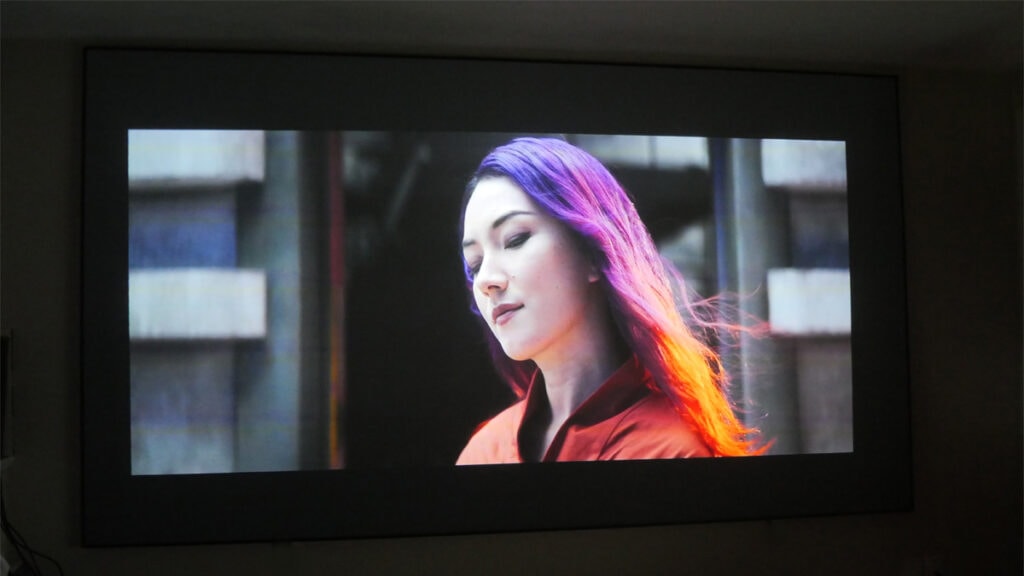
WEMAX says that the screen rejects 90 percent of overhead lighting such as a ceiling light or other ambient light in a room. The light rejecting technology creates a 160 degree viewing angle with .06 gain, WEMAX says.
After using the UST projector for a few months with just a white wall, I can tell you there is a stark difference between using a screen and not using one.
In short, an CLR/ALR screen dramatically improves your picture when it comes to color saturation, black levels, and contrast.
It’s easy to turn on a high-end projector and become impressed with the image you see on a white-painted wall. But over time, I noticed the brightness of the projected image exposed small dents and dings in my white wall that I could not see with normal lighting.
It became distracting over time as I watched movies or TV shows, especially ones that supported 4K or HDR.
I thought I was getting a great picture when I was using just a wall as my screen. But after I used the WEMAX screen for the first time, I understood how wrong I was. The bottom line is that your screen surface matters.
Watching movies or a TV show on the WEMAX 120 inch fixed frame, CLR/ALR screen is a real treat. But a projector screen that measures 120 inches (or 10 feet) diagonally isn’t practical for a typical living room.
- See the latest price for WEMAX 120-inch fixed frame screen.
Are high end projector screens worth it?
High end projector screens can significantly improve contrast and color and overall picture quality. But it really boils down to the quality of the image coming from your projector, and the screen material you are projecting the image on.
A home theater enthusiast, or a budding one, that has already spent thousands on a UST projector or long throw projector will see a lot of benefit from an ALR screen.
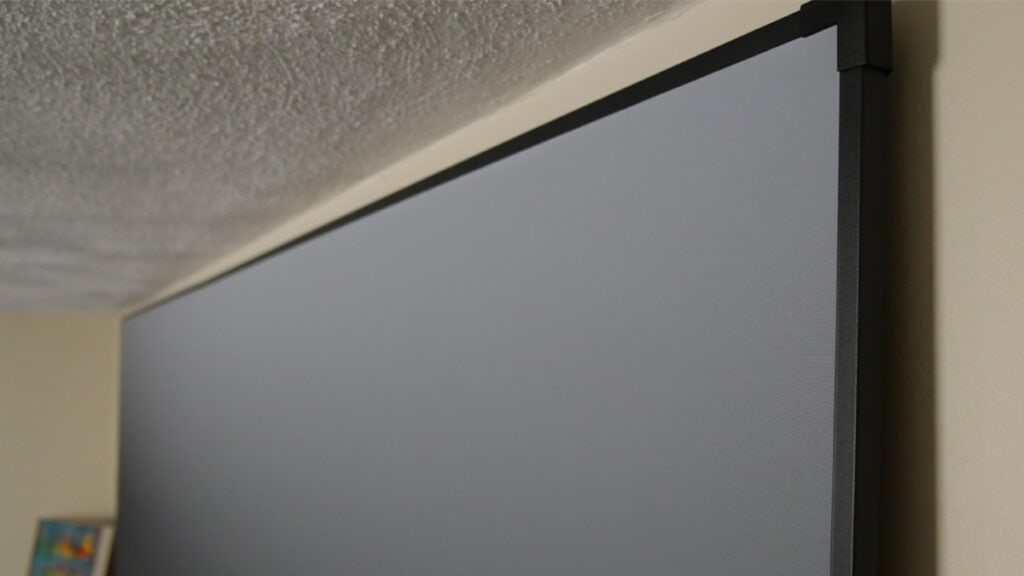
If you are using a portable projector with say 200 to 300 lumen rating such as the Nebula Capsule II, an inexpensive cloth projector screen can improve your picture.
A good rule of thumb is that your budget for a projector screen should be commensurate with how much you spent on your projector. The WEMAX Nova 4K Laser TV retails for about $2,700 when it’s not on sale.
WEMAX’s 120 inch screen, when purchased as a standalone product, currently costs $649 at full price. WEMAX frequently has sales on its website, with some discounts as deep as 20 to 38 percent off.
My go-to projector screen for outdoors is the Yard Master II by Elite Screens.
The Yard Master 2, which I bought in the summer of 2021, is my go-to outdoor projector screen that I use for portable projectors. The Yard Master II comes in a 100-inch diagonal, or 120-inch diagonal model. I chose the 120-inch model.
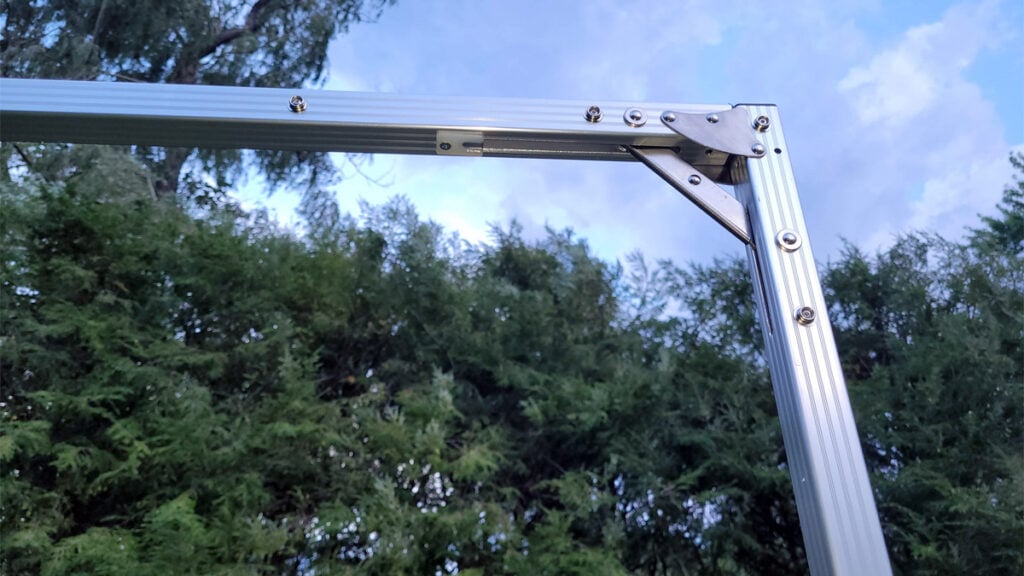
The screen improves a projector’s picture by enhancing contrast, clarity and brightness. The 120-inch version of the Yard Master 2 is sold on Amazon for $179.
Portable projectors that I have tested from Nebula, BenQ and XGIMI all delivered a dramatically better picture on the Yard Master II compared to using a bed sheet.
Keep in mind that even the portable or mini projectors I am mentioning are premium projectors, not to be confused with the $100 projectors that over-promise on specs and deliver an underwhelming picture.
The projection screen is made with material called CineWhite UHD-B, designed to enhance Ultra HD (4K) resolution when it appears on the screen. The screen is made of a flexible PVC material that’s white on the front, and black on the back. It feels really thick in the hand and has equal brightness at an 180 degree angle.
Screen gain
In my experience, screen material definitely impacts picture quality, but so does screen gain.
You should choose a high gain screen when dealing with high levels of ambient light. If you have ever watched a projector screen in a well-lit sports bar, then you were likely watching a high gain screen if the picture was as bright as a TV.
High gain white screens (2.0 or higher) are designed for rooms with high ambient light levels.
But in the case of UST projectors or Laser TVs, the opposite is true. Low gain (1.0 to 1.3) is better for UST projectors and Laser TVs because it minimizes ambient light, giving you a watchable picture in a well-lit room. A low gain screen can give you a wider viewing angle.
The WEMAX CLR/ALR screen has a low gain of .06. The Yard Master 2 that I have mentioned has a gain of 1.3, but delivers a bright picture when I watch my portable projectors at night.
Standard matte white screens are still the most common types of screen on the market with a gain of 1.0 to 1.2.
What it’s like watching a 120 inch projector screen
The WEMAX projector screen has a 16:9 aspect ratio, the same as any Smart TV in today’s market. Most movie theater screens are 21:9. IMAX film is 14:10, and IMAX Digital is 19:10.
Some perspective: My living room TV, a Sony Bravia A80J, is a 65-inch OLED TV that supports HDR10, Dolby Vision and 4K resolution.
Even with a top-of-the-market TV, I know there are certain movies and TV shows I want to watch on a bigger screen. Yes, even if it means sacrificing higher resolution or high dynamic range such as Dolby Vision, I want a bigger screen.
This may seem counterintuitive. But a bigger screen makes me notice more of what’s happening in the frame.
The bigger screen changes my perspective, point of view and experience. Small details, like where a camera is primarily focused for a particular shot, becomes more obvious to me.
I get more out of what any given director is trying to show me.
This big-screen difference is pronounced in movies or shows that have vast landscapes. I watched the entire first season of Outer Range on a projector. The series is an excellent sci-fi western series starring Josh Brolin on Amazon Prime Video.
The setting largely takes place in Wyoming farm country. Most of what I watch reckons with the difference of aspect ratio by putting horizontal black bars at the top and bottom of the screens, which to me, becomes un-noticeable as I immerse myself into a movie or TV show.
While the aspect ratio differs from an actual movie theater screen, the experience of watching a 16:9 projector screen is very similar. You just can’t get the same experience out of a television.
I am basing this assessment with the WEMAX screen which is mounted to my office wall and the Yard Master II, which I only watch outdoors.
Tom Cruise revealed that he disguises himself and sneaks into theaters to watch every new movie on the big screen. I think I get what he is saying, but geez, disguises and movie tickets get expensive fast.
Pros and Cons of projectors screens
The pros of projector screens are straightforward. You can get better color, contrast and deeper blacks with a projector screen, but screen material matters.
If you are buying a projector screen for an ultra short throw projector, then an CLR & ALR screen can make a big difference in terms of overall picture quality.
The cons are that decent screens don’t come cheap. If you invested in a mid-range projector between $400 and $900, then there is a real benefit to getting a screen. But setup can be a pain.
You should consider how much you plan to use your projector, and more importantly, where you plan to project movies and TV shows.
Projectors can be tremendously entertaining, but a decent one can cost as much as a mid-range TV. And a projector screen, especially for an ultra-short throw projector, can cost hundreds or thousands of dollars as well.
The space you have to work with should be a major consideration. If you have the yard space, then great. An outdoor projector screen can add a lot of enjoyment to a summer night.
The same goes for an indoor theater setup. But keep in mind that a 120-inch diagonal screen is 10 feet. You need the space for a giant-size screen to begin with.
A finished basement, loft-style apartment or a high-rise building where moving in a large screen TV might be tough may still have ample wall space for a large projector screen.
If you do buy the WEMAX screen or a similar fixed frame screen, assume it’s a two person job. I was able to assemble and install the WEMAX screen over the course of a few days, but the assembly and installation would have gone a lot smoother with two people.
3 takeaways with projector screens (and projectors)
- A projector is not a TV, but very cool and unique because you are getting a theater-like experience at home.
- Assembly of any fixed frame screen should be a two person job.
- Picking the right room and screen material matters for the best image.
Projector screen FAQs
Do Ultra short short throw projectors need a special screen?
Ultra short throw projectors deliver a better image when using a low gain, ultra short throw screen. A low gain screen will mute the ambient light in a room. A screen designed for UST projectors may also have an ALR and CLR surface that improves picture quality.
Is a 120 inch projector screen big enough?
A 120 inch projector screen is big enough to accommodate long throw or ultra short throw projectors.
measured diagonally, and equals 10 feet. You should make sure there is enough space in your home or yard for a 120 inch screen before buying one.
What is the ideal projector screen size?
The ideal screen size for a projector size is about 120 inches. A 100 inch screen can give you a nice, giant-sized image, but it is pretty close to larger TV sets that go beyond 65 inches. A 120 inch screen will deliver a home theater experience.
How big is a 120 inch projector screen?
A 120 inch screen for a projector is 10 feet, but it is measured diagonally just like a TV screen.
In the interest of full disclosure, WEMAX sent me the ultra short throw screen and projector for testing, but this is not a sponsored article.
Great read! I love how the article dives into the topic with clear explanations. The examples provided really helped me understand the concepts better.